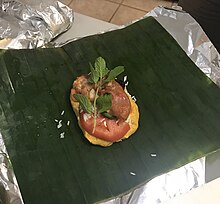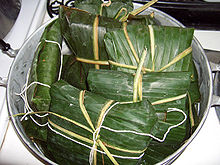Type a search term to find related articles by LIMS subject matter experts gathered from the most trusted and dynamic collaboration tools in the laboratory informatics industry.
 Nacatamal in Nicaragua being served and ready to eat | |
| Place of origin | Nicaragua[1][2][3] |
|---|---|
| Main ingredients | Corn (maize) masa, tomatoes, achiote, chilis, potatoes, banana leaves, Corn husks Fillings; rice and meat (e.g. pork, turkey and chicken) |


A nacatamal (Nahuat: Nakatamal, Nakat "meat", tamal "tamale") (Nahuatl: Nacatamal, Nacatl "meat", tamalli "tamale") is a traditional Nicaraguan dish similar to the tamal and to the hallaca.[4][5][6][7][8][9] Nacatamales originated from the Nicarao tribes who inhabited western Nicaragua, its name originates from the Nawat language and translates to 'meat tamale'.[10][11][12][13][14][15][16] During pre-columbian times, the Nicarao were using hunted meats like deer and turkey with ingredients such as tomatoes, achiote and herbs to season and increase the nacatamal's flavor before being wrapped in corn husks and steamed. After Spanish conquest, nacatamales were made with introduced meats like pork. They also evolved to include flavorful ingredients like onions and banana leaves replaced corn husks.[17][18] The nacatamal is perhaps the most produced within traditional Nicaraguan cuisine and is typically eaten on the weekend, for dinner, or for breakfast; it is usually eaten together with white bread and a caffeinated drink like black coffee, Coca-Cola or Pepsi. It is common to enjoy nacatamales (plural) during special occasions and to invite extended family and neighbors to partake.

A nacatamal is made up of mostly nixtamalized corn masa (a kind of dough traditionally made from a process called nizquezar) and lard, but includes seasonings such as salt and achiote (annatto). This combination is traditionally cooked in a large batch over a wood fire. The result becomes the base for the nacatamal and it is also referred to as masa. This base is ladled onto plantain leaves used for wrapping into large individual portions. The leaves undergo their own preparation separately. Before a nacatamal can be wrapped and brought to the last stage of the cooking process, it must be filled. The filling usually consists of annatto-seasoned pork meat; rice; slices of potatoes, bell peppers, tomatoes, and onions; olives; spearmint sprigs; and chile congo, a very small, egg-shaped chile found in Nicaragua. On occasion, prunes, raisins or capers can be added. The masa and filling are then wrapped in the plantain leaves, tied with a string, and made into pillow-shaped bundles. These nacatamales are then steamed or pressure-cooked for several hours. The entire process is very labor-intensive and it often requires preparation over the course of two days; it may be necessary to involve the whole family to complete it.
Today it is common to wrap nacatamales in both banana leaf and aluminum foil before cooking. Cooking takes up to five hours and at the midway point the nacatamales are turned over to facilitate even cooking.